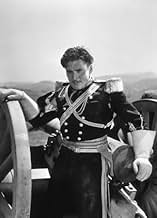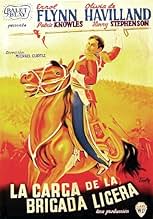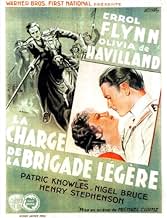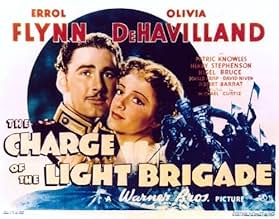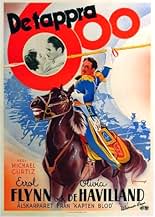AVALIAÇÃO DA IMDb
7,0/10
5,7 mil
SUA AVALIAÇÃO
Adicionar um enredo no seu idiomaA major countermands orders and attacks to avenge a previous massacre of men, women, and children.A major countermands orders and attacks to avenge a previous massacre of men, women, and children.A major countermands orders and attacks to avenge a previous massacre of men, women, and children.
- Direção
- Roteiristas
- Artistas
- Ganhou 1 Oscar
- 4 vitórias e 3 indicações no total
G.P. Huntley
- Major Jowett
- (as G. P. Huntley Jr.)
J. Carrol Naish
- Subadar-Major Puran Singh
- (as J. Carroll Naish)
Princess Baba
- Prema's Mother
- (as Princess Baigum)
Avaliações em destaque
This is Hollywood History at its best. It has nothing to do with the real Crimean War, the Battle of Balaclava, or the Charge of the Light Brigade. It has everything to do with Errol Flynn, Olivia deHavilland, Michael Curtiz, and Max Steiner. Basically, this is a quintessential Warner Bros. adventure film of 1936, one of the best of the breed.
The story starts in Southern California -- or rather, Northern India -- on the outskirts of the British Empire. This setting had been picked up and dusted off after 1935's "Lives of a Bengal Lancer", and would be recreated for "Gunga Din" a few years later, with the same locations and similar plots. Flynn leads a company of British lancers in skirmishes with the local rajah, the villainous Surat Khan -- you can tell he's the villain because of his evil goatee -- and a betrayal and a massacre leads to a mission of vengeance, which reaches its climax in Tennyson's Valley of Death in the Crimea.
Opposite Flynn is, naturally, Olivia deHavilland, without whom Flynn would be lost. Patric Knowles, who played Will Scarlett in Flynn's "Adventures of Robin Hood", is Flynn's brother; David Niven is his sidekick; and Henry Stephenson, Donald Crisp, and Nigel Bruce are the top brass. Director Michael Curtiz brings out another energetic performance from Flynn, although his character here lacks the depths of the heroes of "Captain Blood" or "The Dawn Patrol". Max Steiner's score complements the action perfectly.
"The Charge of the Light Brigade" is quite an epic production, and notorious for the number of horses killed in the battle scenes. That knowledge puts a bit of a damper on the excitement, but it also led to the safety restrictions in place today, banning trip-wires and ensuring the well-being of animals in movies; so, ultimately a good thing. No such measures were ever taken to protect history from the ravages of Hollywood screenwriters: Surat Khan and the country of Suristan never existed, nor did Flynn's 27th Lancers, and although there was indeed a charge at Balaklava, it didn't happen for the reasons depicted in this film. But Flynn and Curtiz didn't care, and neither should the audience.
The story starts in Southern California -- or rather, Northern India -- on the outskirts of the British Empire. This setting had been picked up and dusted off after 1935's "Lives of a Bengal Lancer", and would be recreated for "Gunga Din" a few years later, with the same locations and similar plots. Flynn leads a company of British lancers in skirmishes with the local rajah, the villainous Surat Khan -- you can tell he's the villain because of his evil goatee -- and a betrayal and a massacre leads to a mission of vengeance, which reaches its climax in Tennyson's Valley of Death in the Crimea.
Opposite Flynn is, naturally, Olivia deHavilland, without whom Flynn would be lost. Patric Knowles, who played Will Scarlett in Flynn's "Adventures of Robin Hood", is Flynn's brother; David Niven is his sidekick; and Henry Stephenson, Donald Crisp, and Nigel Bruce are the top brass. Director Michael Curtiz brings out another energetic performance from Flynn, although his character here lacks the depths of the heroes of "Captain Blood" or "The Dawn Patrol". Max Steiner's score complements the action perfectly.
"The Charge of the Light Brigade" is quite an epic production, and notorious for the number of horses killed in the battle scenes. That knowledge puts a bit of a damper on the excitement, but it also led to the safety restrictions in place today, banning trip-wires and ensuring the well-being of animals in movies; so, ultimately a good thing. No such measures were ever taken to protect history from the ravages of Hollywood screenwriters: Surat Khan and the country of Suristan never existed, nor did Flynn's 27th Lancers, and although there was indeed a charge at Balaklava, it didn't happen for the reasons depicted in this film. But Flynn and Curtiz didn't care, and neither should the audience.
Anyone who is expecting a factual retelling of the famous charge at the Battle of Balaclava in the Crimean War had better look to Tony Richardson's film from 1968. This particular Charge of the Light Brigade is a nice action adventure tale from the British Raj in the Kipling mold.
Of course this is all fictional. There's no such person as the evil Moslem ruler played by C. Henry Gordon who massacred a British garrison at a place called Chukoti in 1854. The reason for the famous cavalry charge did not happen so that the regiment could get to nail this dude for his crimes. Yet one thing I found contained more than an element of truth about British rule in India and some of our problems today.
At the very beginning Errol Flynn is accompanying E.E. Clive on a goodwill mission to Gordon. It seems as though there was a treaty with a promised subsidy from Her Majesty that expired with the death of his father. Even though they're not paying him any more to be the British friend, Clive still hopes for Gordon's friendship.
This in fact was how the British acquired 'friends' all over India, they ruled very little of it outright. They won a bidding war that was as acrimonious as the military conflict with other European powers which concluded with the French out of there altogether after the Seven Years War and the Portugese left with a couple of enclaves on the coast.
Clive in fact is one very large fathead, Flynn knows it only too well. In fact though this is how we're still acquiring 'friends' in that region which is now Pakistan.
Thrown into the politics is the rivalry between Errol Flynn and his brother Patric Knowles for Olivia DeHavilland. Originally Anita Louise was supposed to be slated for the part. But after the rave notices started coming in from Captain Blood before some of the romantic stuff was to be shot, Louise was substituted for Olivia DeHavilland and poor Olivia was typecast as the crinolined heroine until she left Warner Brothers.
Jack Warner spent a lot of money on this film. The whole garrison at Chukoti where the massacre took place was built from the ground, up; no miniatures were used. Thousands of horses were bought and about 200 were destroyed in the making of the final charge. So many animals were hurt the ASPCA stepped in and Charge of the Light Brigade got a lot of bad publicity among animal lovers. It did receive an Oscar for Best Assistant Director for the second unit work in depicting the charge when that was a category at the Academy Awards.
Errol Flynn said it was the roughest film he ever made in terms of pure physicality. It was pretty rough on Olivia DeHavilland as well who Flynn accidentally cold-cocked during a scene. These crinolined heroines do have it rough.
One of my favorite character actors, Henry Stephenson, plays the fictional Charles Masefield in this film. Stephenson in every film he did always embodied the stiff upper lip, attention to your duty ethic that the United Kingdom prides itself in. He's always a man of class and refinement. And he firmly believes in the John Ford mantra, when the legend becomes fact, print the legend.
Which is what Alfred Lord Tennyson gave us when he wrote that poem extolling the young men of that generation who died at Balaclava. We're watching the legend here.
Of course this is all fictional. There's no such person as the evil Moslem ruler played by C. Henry Gordon who massacred a British garrison at a place called Chukoti in 1854. The reason for the famous cavalry charge did not happen so that the regiment could get to nail this dude for his crimes. Yet one thing I found contained more than an element of truth about British rule in India and some of our problems today.
At the very beginning Errol Flynn is accompanying E.E. Clive on a goodwill mission to Gordon. It seems as though there was a treaty with a promised subsidy from Her Majesty that expired with the death of his father. Even though they're not paying him any more to be the British friend, Clive still hopes for Gordon's friendship.
This in fact was how the British acquired 'friends' all over India, they ruled very little of it outright. They won a bidding war that was as acrimonious as the military conflict with other European powers which concluded with the French out of there altogether after the Seven Years War and the Portugese left with a couple of enclaves on the coast.
Clive in fact is one very large fathead, Flynn knows it only too well. In fact though this is how we're still acquiring 'friends' in that region which is now Pakistan.
Thrown into the politics is the rivalry between Errol Flynn and his brother Patric Knowles for Olivia DeHavilland. Originally Anita Louise was supposed to be slated for the part. But after the rave notices started coming in from Captain Blood before some of the romantic stuff was to be shot, Louise was substituted for Olivia DeHavilland and poor Olivia was typecast as the crinolined heroine until she left Warner Brothers.
Jack Warner spent a lot of money on this film. The whole garrison at Chukoti where the massacre took place was built from the ground, up; no miniatures were used. Thousands of horses were bought and about 200 were destroyed in the making of the final charge. So many animals were hurt the ASPCA stepped in and Charge of the Light Brigade got a lot of bad publicity among animal lovers. It did receive an Oscar for Best Assistant Director for the second unit work in depicting the charge when that was a category at the Academy Awards.
Errol Flynn said it was the roughest film he ever made in terms of pure physicality. It was pretty rough on Olivia DeHavilland as well who Flynn accidentally cold-cocked during a scene. These crinolined heroines do have it rough.
One of my favorite character actors, Henry Stephenson, plays the fictional Charles Masefield in this film. Stephenson in every film he did always embodied the stiff upper lip, attention to your duty ethic that the United Kingdom prides itself in. He's always a man of class and refinement. And he firmly believes in the John Ford mantra, when the legend becomes fact, print the legend.
Which is what Alfred Lord Tennyson gave us when he wrote that poem extolling the young men of that generation who died at Balaclava. We're watching the legend here.
Well, if you want to learn about crimean war or the famous attack, put into immortal words by Tennyson's poem, this one is definitely not for you. Turn to the 1968 GB movie of the same title for this. If you want thrilling entertainment and great battle scenes, this one is right for you. Errol Flynn at his usual best except loosing his usual love interest (O.d. Havilland) to his younger brother and his life to his revenge. The war scenes are staged perfectly alike Custer's fight in They died with their boots ... and the acting is good, also for younger side kicks like David Niven. Taking for the entertainment it is, not for anything serious and you will love it.
Errol Flynn says to heck with orders and leads his men into battle against villainous Surat Khan (C. Henry Gordon) to avenge Khan's massacre of men, women, and children. Highly enjoyable adventure yarn, loosely based on historical events. Superb action scenes, fine Max Steiner score, and great Michael Curtiz direction. It's always nice to see Errol Flynn and Olivia de Havilland together, although this has the surprising twist of Olivia preferring Patric Knowles to Errol. Exceptional Warner Bros. supporting cast includes David Niven, Donald Crisp, Henry Stephenson, J. Carrol Naish, and many other familiar faces. Judging by some of the reviews here, it would appear the history police have written many tickets for this one. At the risk of incurring their terrifying wrath, I'm gonna say nerts to them! Just enjoy the movie. If you want to learn about the history behind the movie, read a book.
Director Michael Curtiz went all out in this 1936 version of "The Charge of the Light Brigade", and considering the era, he made a darn good job of it - sure, he threw history out of the window, and created a very fictitious story, but when it came to the actual Charge, it was a masterpiece of staging and direction. He was aided by that great pair - Errol Flynn and Olivia de Havilland (lovely as usual!) who kept the interest all the way through. The supporting cast was really star-studded, with Donald Crisp, Henry Stephenson, Nigel Bruce and Spring Byington, and in a very early role in his career, David Niven. If you had to pinpoint a weak link, it was Patric Knowles as Flynn's brother. But all that aside, it is a couple of hours of excitement and sheer entertainment while waiting for the Charge and what is going to happen to the nasty Surat Khan!! The remakes since, while having the benefits of far greater technical tools, falls way short of this epic.
Você sabia?
- CuriosidadesFor the filming of the climactic charge, one hundred twenty-five horses were trip-wired. Of those, twenty-five were killed outright or had to be put down afterward. The resulting public furor caused the US Congress to pass laws to protect animals used in motion pictures. Star Errol Flynn, a horseman, was so outraged by the number of horses injured and killed during the charge, and by director Michael Curtiz's seeming indifference to the carnage, that at one point as he was arguing with Curtiz about it, he could contain himself no more and actually physically attacked him. They were pulled apart before any serious damage was done, but it put a permanent freeze on their relationship; even though they made subsequent films together, they despised each other and would speak only when necessary on the set.
- Erros de gravaçãoAfter the massacre, Flynn sympathetically listens to Major Singh crying over the body of his murdered son Prema who is clearly wiggling his toes in the foreground of the scene.
- Citações
[first lines]
Sir Humphrey Harcourt: How do you fellows manage to look so comfortably, Vickers?
Major Geoffrey Vickers: We may look it Sir, but we're not. They say the first forty years are about the hottest up here on the frontier, after that you get used to it.
Sir Humphrey Harcourt: Really?
- Cenas durante ou pós-créditosOpening credits: This production has its basis in history. The historical basis, however, has been fictionized for the purposes of this picture and the names of many characters, many characters themselves, the story, incidents and institutions, are fictitious. With the exception of known historical characters, whose actual names are herein used, no identification with actual persons, living or dead, is intended or should be inferred.
- Versões alternativasAlso available in a computer colorized version.
- ConexõesFeatured in Hollywood and the Stars: The Swashbucklers (1964)
- Trilhas sonorasGod Save the Tsar
(uncredited)
Music by Alexis Lvov
[The Russian national anthem from 1833 to 1917 played as part of the score during the charge at Balaklava]
Principais escolhas
Faça login para avaliar e ver a lista de recomendações personalizadas
- How long is The Charge of the Light Brigade?Fornecido pela Alexa
Detalhes
- Data de lançamento
- País de origem
- Idioma
- Também conhecido como
- A Carga da Brigada Ligeira
- Locações de filme
- Lake Sherwood, Califórnia, EUA(massacre at the boats)
- Empresa de produção
- Consulte mais créditos da empresa na IMDbPro
Bilheteria
- Orçamento
- US$ 1.200.000 (estimativa)
- Tempo de duração1 hora 55 minutos
- Cor
- Mixagem de som
- Proporção
- 1.37 : 1
Contribua para esta página
Sugerir uma alteração ou adicionar conteúdo ausente

Principal brecha
By what name was A Carga de Cavalaria Ligeira (1936) officially released in India in English?
Responda

